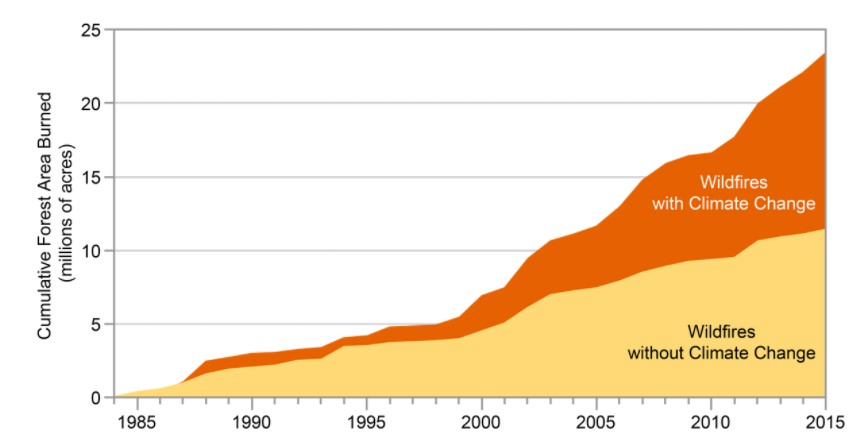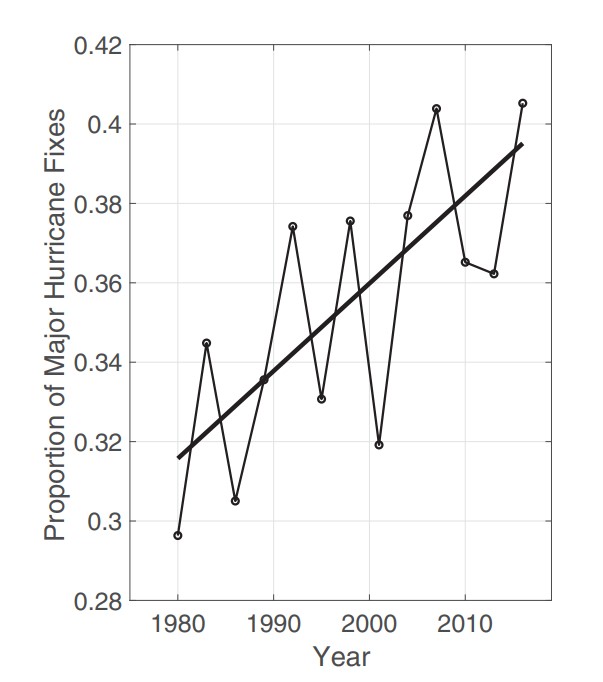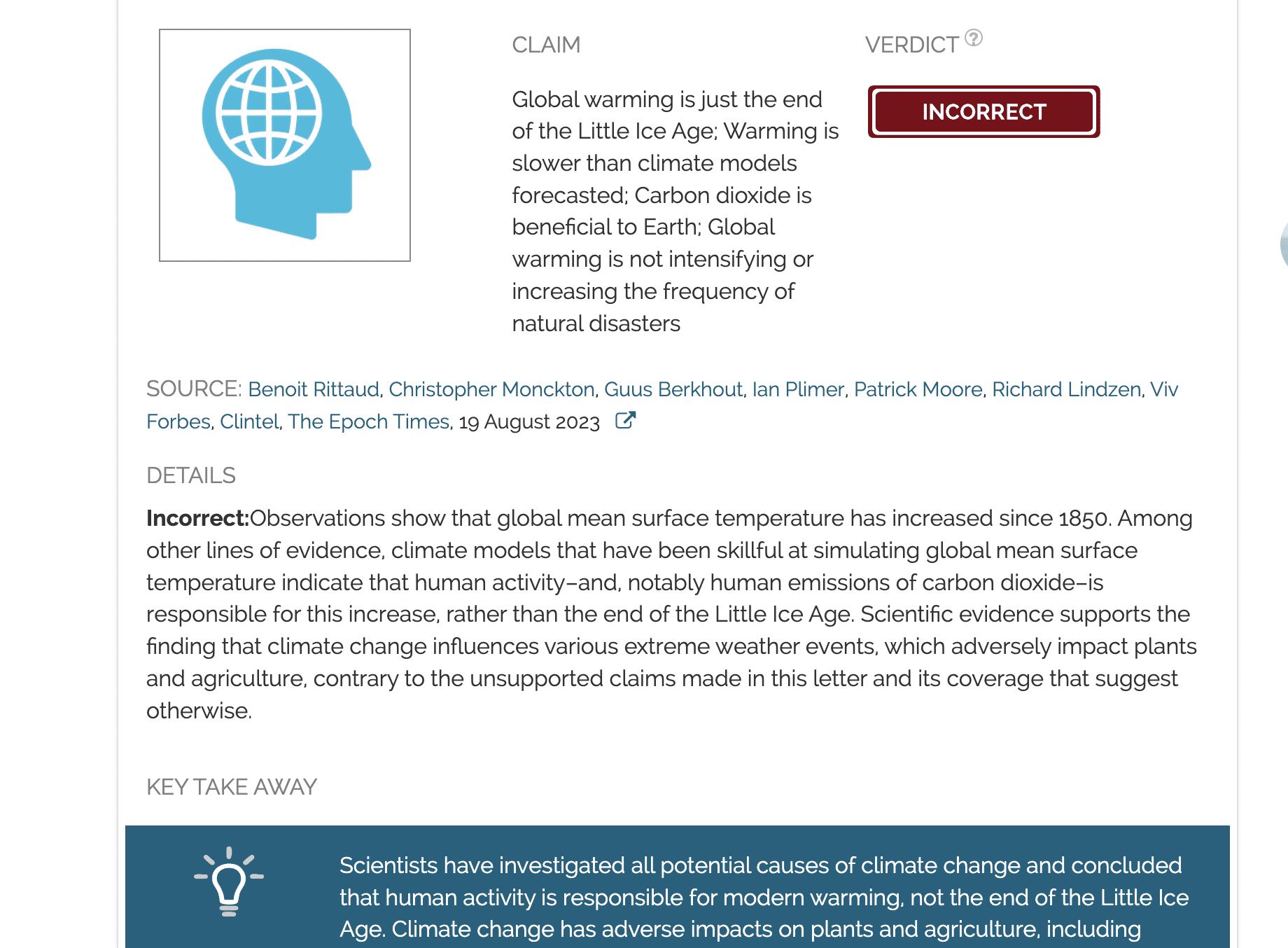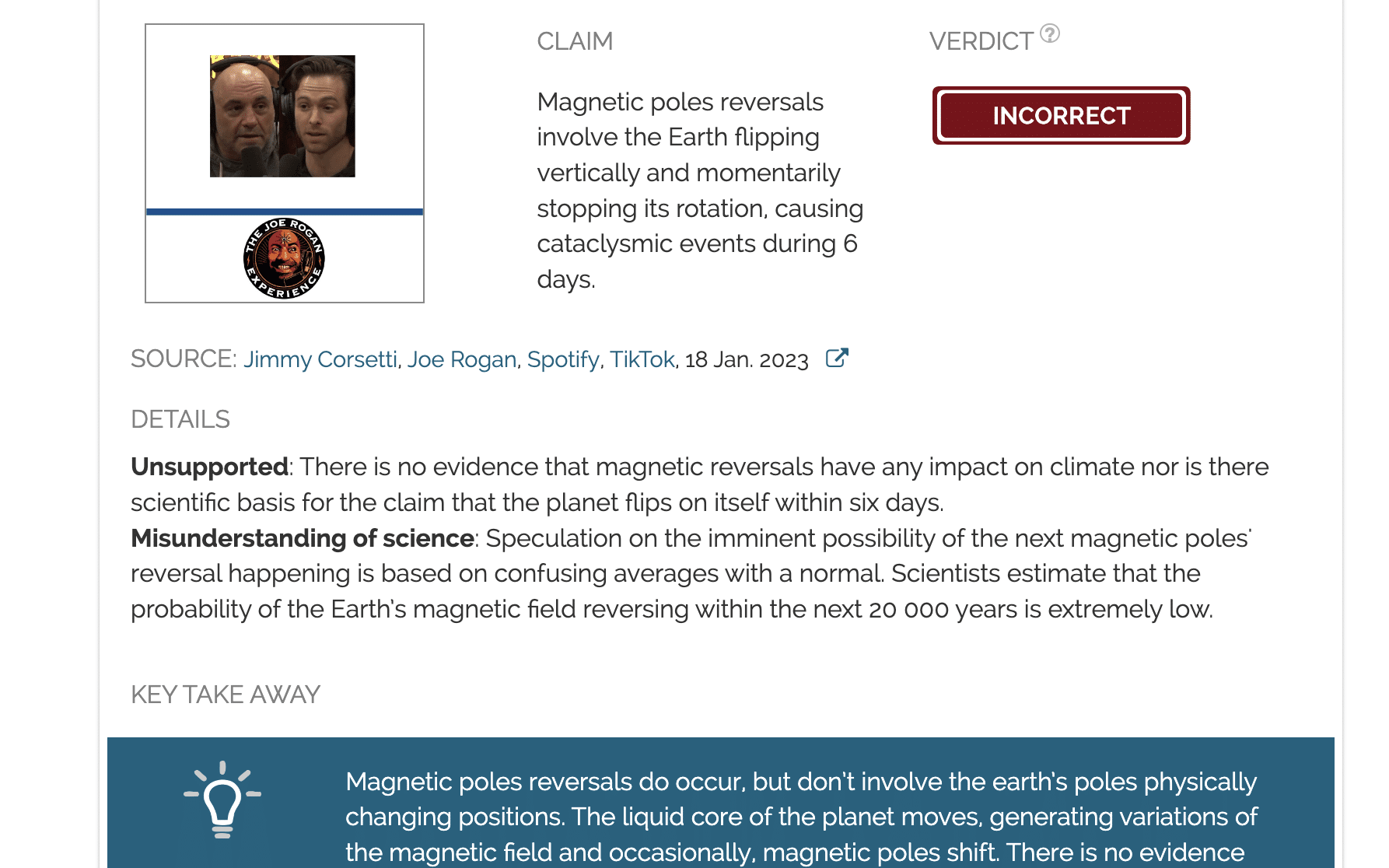- Climate
Breitbart article makes numerous false claims about the impacts of climate change, based on Global Warming Policy Foundation post
Reviewed content
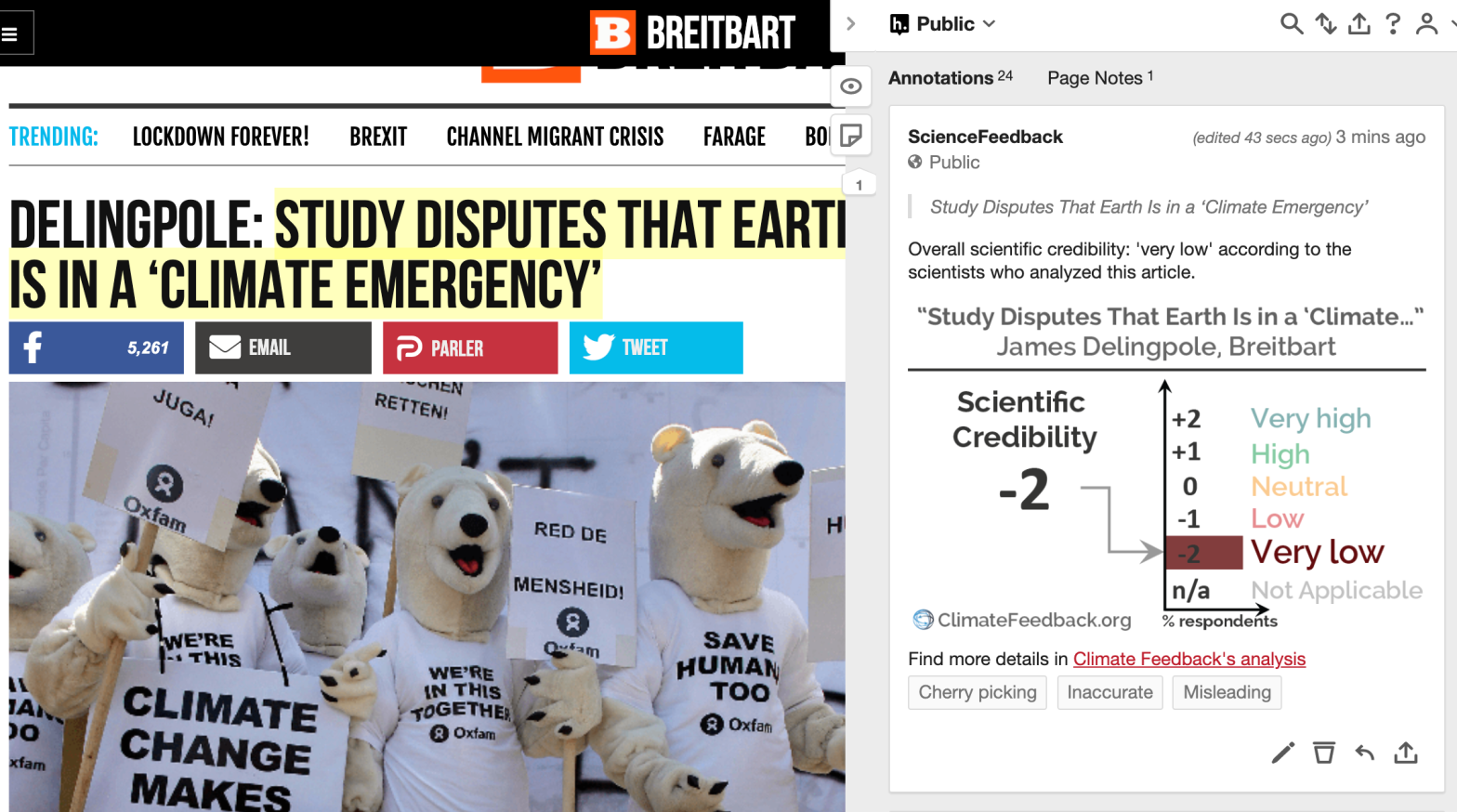
Headline: "Study Disputes That Earth Is in a ‘Climate Emergency’"
Published in Breitbart, by James Delingpole, Indur Goklany, on 2021-02-07.
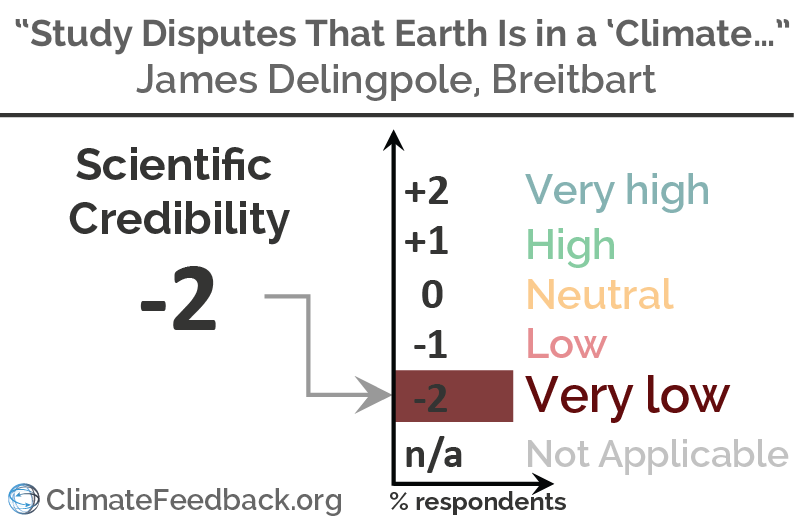
Summary
The article was published by Breitbart as well as dozens of other blogs, such as Climate Change Dispatch, Principia Scientific, Climate Depot, and Technocracy News. It is repeating a series of claims made in a blog post from the Global Warming Policy Foundation (GWPF), a political advocacy organization, which has published misinformation in the past. Scientists who reviewed the article found that it includes several inaccurate claims and cherry-picks information in a way that misleads readers about the scientific understanding of climate change.
Specifically, it states, “Most extreme weather phenomena have not become more extreme, more deadly, or more destructive”. Contrary to this claim, the IPCC reports and numerous scientific studies demonstrated that global warming increases the intensity of many types of extreme weather events, as the scientists explain below[1-6]. In addition, some extreme weather events, such as heat waves and intense rainfall events, are becoming more common and the trend is expected to continue, as described in a previous Climate Feedback review.
The article is built on a series of misrepresentations of the expected consequences of climate change, a technique known as a straw man argument. For instance, the author presents an assumption that climate change will increase drought globally and then refutes this non-existent expectation of climate science. As explained by Dr. Swain below, “it doesn’t really make sense to make blanket statements regarding overall global drought trends, since only some places are expected to get drier (and others wetter) in a warming climate”.
The article also deliberately ignores multiple factors that affect some phenomena to argue against the influence of climate on them. For instance, while fatality due to weather events has either remained constant or declined over time for some types of weather events[7], this is primarily due to improvements in warning and evacuation systems and has little to do with climate change, as the reviewers explain below.
Contrary to the article, climate change has caused some extreme weather events to be more destructive, as scientists explained in a previous review. For example, global warming is causing the oceans to increase in temperature, more moisture in the atmosphere, and sea-level to rise, leading to more extreme precipitation and damage from tropical storms and hurricanes[4,5]. The area burned by wildfires in the western US has also increased significantly due to climate change (see figure below).
Figure 1—Cumulative forest area burned by wildfires in the western US from 1984-2015. From Fourth National Climate Assessment (2018)[8].
The article also makes several misleading claims about the impacts of nitrogen and carbon dioxide fertilization on food production. Carbon dioxide has increased plant growth in some regions of the world, but these effects are often limited by nutrient availability and can saturate over time[9,10]. Global warming is also damaging crop yields and slowing plant growth under some circumstances, and these effects are expected to continue in the future[11-13], as the reviewers explain below.
It is also misleading to call the GWPF post published by Dr. Indur Goklany a “study”, as it does not include any original research nor was it peer-reviewed or published by a reputable scientific organization. Furthermore, Goklany is an electrical engineer, not a climate scientist, who hasn’t published any peer-reviewed research in at least the past decade on the topics he wrote about in the GWFP post.
See all the scientists’ annotations in context. You can also install the Hypothesis browser extension to read the scientists’ annotations in context.
Reviewers’ Overall Feedback
These comments are the overall assessment of scientists on the article, they are substantiated by their knowledge in the field and by the content of the analysis in the annotations on the article.
This article uses a single poorly-sourced, non-peer reviewed report as a basis for making numerous misleading and in multiple instances demonstrably false claims regarding climate change and its global implications.
The article is mostly inaccurate and uniformly misleading. For example, in declaring that hurricane frequency is not increasing, it neglects to mention that there was never a consensus prediction that the frequency of all hurricanes would increase, or in stating that weather-related deaths are decreasing fails to mention that the reasons for that have nothing to do with climate change but rather with rapidly improving warnings and preparedness.
This is a biased and purposely misleading article that contradicts evidence-based scientific literature. The authors did not care to cross-check the claims made by Mr. Goklany nor to set them in the broader context of the scientific evidence about climate change and impacts (e.g. IPCC reports)[1].
The article’s scientific credibility is very low. The author cherry-picks data, makes broad generalizations and characterizations based on incomplete or flimsy reasoning, and repeatedly misinterprets technological and economic progress in justifying false claims and misinformation minimizing global warming impacts.
Annotations
The statements quoted below are from the article; comments are from the reviewers (and are lightly edited for clarity).
“according to a study for the Global Warming Policy Foundation”
It is important to note that the purported “study” that is the subject of this article is not actually a study in any meaningful sense of the word. It is written by a single author who is not a physical or climate scientist, contains no previously unpublished data, and has not been peer-reviewed.
This is not a “study”. It is a single-author, non-peer reviewed opinion piece that cherry-picks, misinterprets and conflates previous findings.
“Most extreme weather phenomena have not become more extreme, more deadly, or more destructive.”
There is an extensive and growing body of evidence showing that many kinds of extreme weather have increased in magnitude and/or frequency as the climate has warmed. Evidence is strongest regarding increases in extreme heatwaves and extreme precipitation events[14], but there is also extensive evidence regarding increasing intensity of other physical event types such as droughts, wildfires, and hurricanes (especially in specific regions). Indeed, there is now an entire sub-field of climate science, known as “extreme event attribution,” devoted to understanding how climate change is affecting the occurrence and intensity of extreme weather-related events[15].
Globally, the leading causes of mortality from weather phenomena during the period 1981-2020, in order, are drought, tropical cyclones, heat waves, floods, and convective storms. For most of these, when normalized by population, there are either no significant trends or downward trends[7]. In most, if not all, cases, this is attributable to improved emergency management. For example, there have been large decreases in tropical cyclone fatality thanks to far better warning, more and better evacuations, and in some places like Bangladesh, the massive construction of evacuation shelters[16].
Weather is taking fewer lives, but when one looks at damage the story is quite different. Since the early 1970s there has been a 380% increase in global weather-related damage normalized each year by world domestic product. Some of this is demographic; for example, there has been a 200% increase in coastal population, but much of the rest is owing to worse weather disasters, as measured by damage.
From a strictly meteorological perspective, the latest consensus papers published in 2019 by Knutson et al. show a strong consensus that tropical cyclones will become more intense (but not necessarily more frequent) as the climate warms[4], and a paper published by Kossin in 2020 shows that the fraction of high intensity tropical cyclone observations has been increasing (see figure below)[17].
Figure 2—The proportion of major hurricane intensities to all hurricane intensities globally from 1979-2017. Data is binned into 3-year periods. The proportion of global major hurricanes increased by 25% over the 39-year time period analyzed. From Kossin et al. (2020)[17].
There is also a unanimous consensus that tropical cyclones will produce more rain, and in places with sufficient rain measurements, there is strong evidence for heavier rain events[4]. There is also strong evidence for an increase in the incidence of drought in some regions[1].
In a nutshell, deaths from extreme weather events are indeed decreasing but this is because of improving warnings, evacuations, and shelters, mostly in the developing world. There is strong evidence that weather events globally are becoming more destructive and more extreme[1].
“Empirical evidence directly contradicts claims that increased carbon dioxide has reduced human wellbeing. In fact, human wellbeing has never been higher”
The increase in atmospheric carbon dioxide does not directly affect human health, but it does directly cause increased global temperature and ocean acidification, and both of these are having major detrimental effects on human and ecosystem wellbeing.
Carbon dioxide increase does not directly affect human well being, but the main process responsible for increasing CO2 is also responsible for air pollution that does directly affect human health[18,19].
In addition, many environmental consequences from anthropogenic greenhouse gas emissions and global warming have heavy costs in terms of human lives and life quality, for example heatwaves, famines due to drought, increase/expansion in infectious diseases[20,21].
There are “More hot days and fewer cold days”
This is essentially the only scientifically accurate claim I can discern in the entire article.
”Cyclones/hurricanes [are not] more intense or frequent”
While it is true that there remains no strong evidence for an increase in tropical cyclone (hurricane) frequency on a global basis, there is evidence that the most intense tropical cyclones are indeed becoming stronger (in terms of maximum wind speeds and minimum central pressure[17] and are producing more extreme rainfall[5].
In fact, these trends are consistent with predictions regarding tropical cyclone behavior due to global warming: there is a strong expectation that the maximum potential intensity of hurricanes will increase due to rising ocean temperatures, even as the overall frequency of such storms does not change greatly or perhaps even decreases[4].
“Tornadoes [are not] increas[ing] and becom[ing] more intense”
There is relatively little evidence in either direction at this point in time regarding global or even regional trends in tornado frequency/intensity. This is largely due to sparse and temporally inhomogeneous historical records in the United States, and virtually non-existent records in other regions. There is some evidence of regional shifts in tornado frequency[22], and perhaps an increase in overall tornado “power” in the United States[23], but in general there is an absence of strong evidence regarding this claim.
Future projections regarding climate change and tornado risk are of somewhat low confidence, but there is evidence that atmospheric environments favorable for severe convective storms (which are the types of storms capable of producing tornadoes) may increase in the future due to climate warming[24,25].
”Droughts [are not] more frequent and intense”
Observed spatial trends in global hydroclimate over the past century have been consistent with those expected from human influence in the climate system[26]. In many mid-latitude and subtropical regions, this has indeed included an increase in the frequency/intensity of drought[27,28]–but in other regions (such as the Northern Hemisphere high latitudes), this includes an increase in moisture availability and decrease in drought (as expected from climate model simulations). Therefore, it doesn’t really make sense to make blanket statements regarding overall global drought trends, since only some places are expected to get drier (and others wetter) in a warming climate.
There has been no increase in the area burned by wildfire; the area peaked in the mid-19th century
This is highly misleading, as it conflates different types of fire (many of which are not wildfires to begin with). Overall trends in area burned globally are strongly driven by decreases in intentional agricultural burning in tropical areas, which is not related to climate change.
In regions where non-agricultural fires occur naturally (including the western United States[e.g., 29-31], eastern Australia[32], and the Siberian Arctic[33], for example) there is strong evidence that climate change has already increased the severity and extent of wildfire[34].
The statement that “Area burned by wildfire increasing — No (area peaked in mid-19th century)” is misleading in its implication that climate change is not making wildfires worse or more extreme and deadly. The overall global decrease is mostly driven by less fire in what used to be more extensive savannahs and grasslands and is largely due to the human driven removal of flammable vegetation. In quantitative terms, fire in those grassy ecosystems account for around 70% of the total global area burnt, so the reduction in fire activity here outweighs the increase in burned area that we are seeing in other parts of the world over the last two decades where fires have greater impacts such as Canada, parts of the USA or Siberia.
In other words, where humans have not converted flammable landscapes to less or-non flammable landscapes by removing or changing the vegetation, warming temperatures are, overall, associated with an increase in fire activity. A very thorough recent global analysis of trends and fire knowledge overall is here[35].
And very importantly, associated with these regional increases, we have also seen a rise in fire impacts, for example in the number of fatalities. As reported in our wildfire trend analysis, in the period 1994-2014, an average of 71 deaths per year had been recorded in wildfire disasters recorded in the International Disaster Database[36]. Since 2015 this has risen to 122 deaths per year.
The observed decline in global average area burned has been misused numerous times to support false claims about the role of climate change in wildfire trends. Climate change as well as human activities affect global fire activity (see here for a summary and update on Doerr and Santin, 2016[36].
“Cereal yields [are not] decreasing”; “they have tripled since 1961”; “Food supplies per capita [are not] decreasing” — they “increased 31 per cent since 1961”
This is also misleading because crop yield increase since the 1960s is related to the massive increase in nitrogen fertilization and agricultural industrialization. However, studies have shown that extreme events made more likely by global warming are associated with losses in crop yields[37-39] and peaks in crop prices[40].
There are no “Land area and beaches shrinking, coral islands submerged”, instead there has been “marginal expansion”

Associate Professor, University of Illinois
Observed expansion of beach areas is mainly due to human intervention and coastal management, not climate change.
”mortality from ‘Extreme Weather Events’ has declined by 99 per cent since the 1920s”
No reference to this claim. On the contrary, scientific attribution studies such as Mitchell et al. 2016 show clear impacts of extreme events on excessive mortality[21].
”fewer people are dying from heat; death rates from climate-sensitive diseases like malaria and diarrhoea have decreased (since 1900 malaria death rates have declined 96 per cent); hunger rates have declined; poverty has declined (GDP per capita has quadrupled since 1950 even as CO2 levels have sextupled); life expectancy has more than doubled since the start of industrialisation; health adjusted life expectancy has increased”
All of these have multiple confounding factors (e.g. technological, health and economical development) so that these changes cannot be directly linked to CO2, but also do not invalidate negative effects of climate change. As such, this statement is simply misleading.
“Almost everywhere you look, climate change is having only small, and often benign, impacts. The impact of extreme weather events ― hurricanes, tornadoes, floods and droughts ― are, if anything, declining.” This contradicts the evidence presented in dozens of scientific contributions, and summarized in IPCC reports[1]. This statement can be characterized as wishful thinking — contradicts all science-based evidence. It is misleading to state that flood magnitudes do not increase. Trend analyses of flood magnitudes in Europe have shown increases, decreases and no change depending on the location[41]. For example, increases have been observed in Ireland (during 1976–2009), Switzerland, Slovakia (for small catchments of 5–150 km2) and Norway (for rainfall-dominated catchments)[6,42-45]. Snowmelt floods, on the other hand, have been observed to decline in flood magnitude for Norway[45,46]. Rain-on-snow events (including floods caused by rain-on-snow) have been observed to increase at high elevations and decrease at low elevations, for Norway[47]. Future projections of flood magnitudes also show increases, decreases and no trends, depending on the location, catchment properties and flood-generating process. It is therefore misleading to state that flood magnitudes do not increase in the future. Madsen et al. (2014) write: “With respect to hydrological projections of changes in flood frequency at the catchment scale, both positive and negative changes in extreme discharge are projected. Increases in peak discharges are projected for sub-basins in the Scheldt and Meuse in Flanders (Boukhris and Willems, 2008, Willems et al., 2010), for catchments in Denmark (Sunyer et al., 2010, Madsen et al., 2013), for Bavaria and Baden-Württemberg (Hennegriff et al., 2006) and Saxony-Anhalt (Hattermann et al., 2011) in Germany, for western, mid-northern and all of coastal Norway (Lawrence and Hisdal, 2011), for the Hron catchment in Slovakia (Hlavcová et al., 2007), in coastal, southern areas in Sweden (Bergström et al., 2012), and in many catchments within the UK (Reynard et al., 2001, Reynard et al., 2010, Prudhomme et al., 2003, Kay et al., 2006, Kay and Jones, 2012).”[48] “Death rates from such events have declined by 99% since the 1920s.” So mortality rates from hurricanes and tornadoes have decreased since the 1920s until now. Is this because these storms are more “benign” now than they were in the past as the author suggests, or is it because we are now much better at forecasting and preparing for them now than we were 100 years ago (before the invention of computers)? “Even sea-level rise — predicted to be the most damaging impact of global warming — seems to be much less of a problem than thought, according to to the study’s findings.” This is literally the opposite of what a growing body of recent evidence has shown. Research actually shows that rates of global sea level rise have accelerated in recent years[49], and estimates regarding the upper end of plausible further SLR over the coming century have actually increased considerably as the non-linear contribution by continental ice sheets comes into clearer focus[50]. So, if anything, sea level rise is becoming more of a problem than previously thought. “A recent study showed that the Earth has actually gained more land in coastal areas in the last 30 years than it has lost through sea-level rise.” Please provide this peer-reviewed study by a legitimate practicing environmental scientist to support this counterintuitive statement. This statement is false. The Earth has perhaps gained more “sandy beaches” along coastal areas according to the study cited. However, this is primarily due to coastal management, not sea-level rise. In fact, the authors of that study find large beach erosion in protected coastal areas (ie. regions without human intervention)[51]. “Nitrogen fertilisers and carbon dioxide fertilisation have together increased global food production by 111 per cent.” These are cherry-picked and highly misleading. The article cites increasing cereal yields as a reason why climate change is not a problem, but ignores the large evidence base showing that rising temperatures are damaging crop yields and slowing yield growth[11-13]. Moreover, benefits from CO2 fertilization saturate whereas damages from warming accelerate over time[9], meaning extrapolation from the historical record is not meaningful. To claim that nitrogen fertilizers are a benefit of fossil fuels is an extremely tortured logic and misleading in the extreme – synthetic fertilizers have very little to do with the question of how much to reduce energy generation from fossil fuels.REFERENCES:

